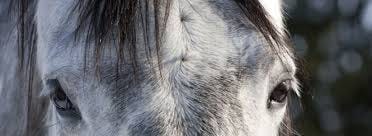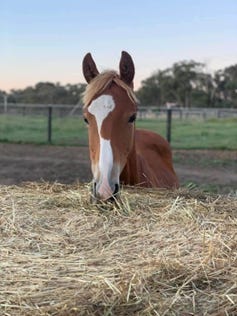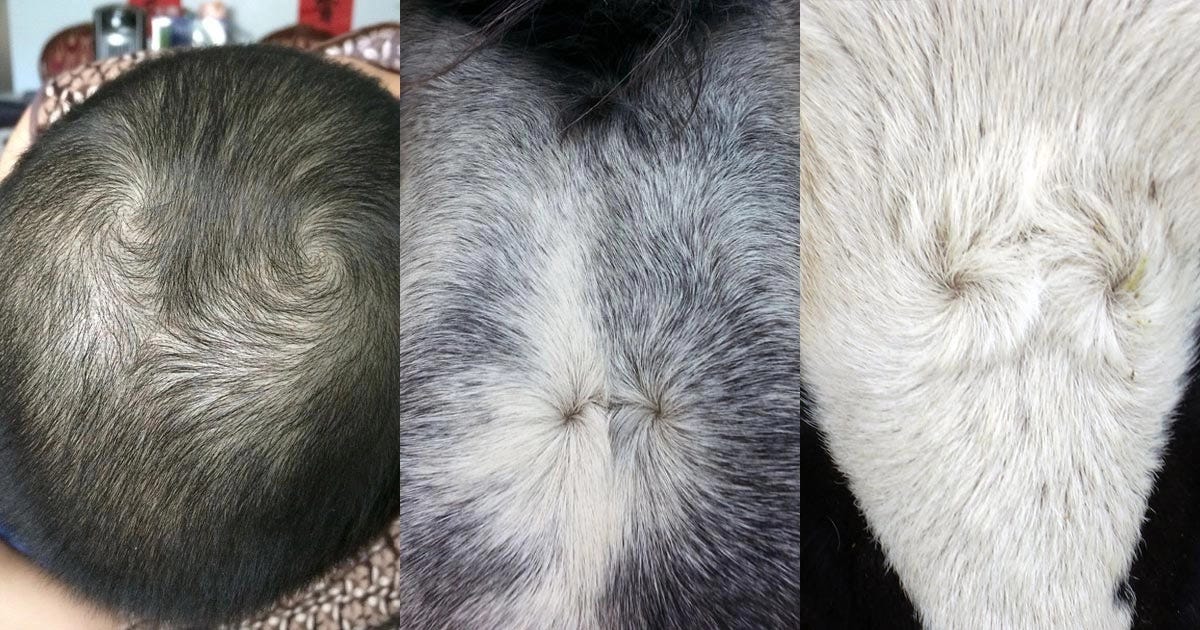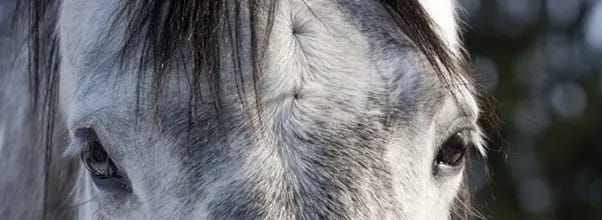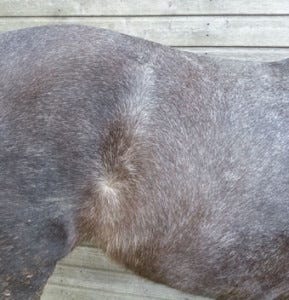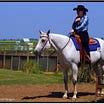White markings and Whorls
# An excerpt from my course "Horse Colour Breeding" for paid subscribers.
Note: this is a long read, so be sure to click the little dots if it is truncated in your inbox.
ABSENCE OF COLOUR
It is important to understand that white hairs are not a colour. They are absence of colour. They are there because there is no colour-producing pigment, no melanocytes to produce colour in the skin where the white hairs originate.
In its simplest terms, all horses start out as a foetus with white pigmented (pink) skin. In the early stages of development, the colour genes of the foetus are activated and the melanocytes spread throughout the body from special sites, called crests, such as the "neural crest". These are typically associated with whorls.
Whorls are mechanisms to radiate the angles of feather or hair growth to allow for changes in shape or angles of the animal itself. – Don Burke, Budgerigars, The Colour Revolution, 2024
The body tries to protect sensitive areas so in a mostly white horse, colour is still normally seen on the flanks or the poll. Where white covers the eye – the horse will likely have a glass eye.
Incorrect formation may also damage development of the brain or ear during early development. This explains why animals which are almost all white may be born deaf.
Cloning has shown that siblings (which are full relations and therefore have exactly the same genotype) can have varied white markings, proving this to be part of foetal development, not strictly under the control of genes.
This is normally a relatively orderly process, but sometimes quite skewed or interrupted markings are produced, hence we might get a blaze with a big round patch extending into the middle of it. (Remember that the white is not added on top of existing colour. Colour is 'creeping' into the white areas, not the other way around.)
Here I quote from Don Burke's marvelous new book, Budgerigars, The Colour Revolution 2024. You can buy the book here. Budgerigars (newhollandpublishers.com) or from any good bookstore.
– Crested Budgerigars – a new whorled view.
What about the electrome?
The electrome uses the tiniest of electrical currents, around 0-90 millivolts, to make the template of our bodies, which genes are unable to do by themselves, e.g. two eyes, one nose, plus a backbone etc. After laying down the structural plan, the electrome dictates which bit goes where. Ninety millivolts creates skeletal muscle, seventy millivolts creates nerve cells etc.
These voltage chemicals do more than just form a blueprint however, they actually instruct the genes when to go to work and what to do and where to do it.
We are reasonably confident, that the electrome controls both placement and shape of whorls. In mammals, hair whorls force the coat to lie flat on the animal and also to shed water when the coat is wet.
Whorls of hair or feathers occur during the embryological development of babies. They are largely controlled by the electrome which organises the genes. Thus we can't expect precise results from whorl matings.
For example, when scientists raised 15 or 20 "identical" cloned Friesian cows, the white markings were different on all of them. Even though they were all genetically identical!
Equally, identical human twins, often have different hair whorls on their heads. Sometimes the whorls are clockwise in one twin, and anticlockwise in the other.
The electrome is very efficient at aligning and regulating animal bodies since that is its basic function in life. Genes play almost no part in whorls of any type. If a gene is involved, it is controlled by the electrome. – Don Burke (with permission.)
The following information is provided by my recommended guest author, Theresa of Curious Equestrian. You can find her on Substack here.
This is an excerpt from one of her previously published posts on July 21 2024, which I am sure you will find very interesting. The author is Charlotte Cannon, who has made a lifetime’s study of whorls. Do read it and if you enjoy it, do subscribe to Curious Equestrian’s posts.
Whorlology
Charlotte Cannon
From The Curious Equestrian
I became fascinated by the clues hidden in whorls and I talked to everyone I could find to learn more. I studied countless horses and their whorl patterns, comparing the patterns to their performance. Jerry's theories were right on the money every time! I even started to seek out world champions from all different areas, jumping, cutting, reining, eventing, etc. I observed those 'perfect' whorl patterns time and time again.
I braid and band hundreds of horses each year and have gotten to observe tremendous numbers of horses and their whorl patterns. Successful horses are as shockingly consistent as poor performers are predictable.
Not everyone is eager to learn and embrace this idea.
I have experienced many violent outbursts from the owner of a horse with a challenging whorl pattern. Although this horse has already hurt them they are certain it will become their perfect dream partner with the right trainer or programme.
One evening after a Craig Johnson reining clinic, I joined Craig and several other clinic participants and spouses for dinner at a local restaurant. The conversation was dull and everyone was putting on fake and 'perfect' facades for Craig who appeared to see right through them.
I decided to shake the party up a bit by bringing up whorls. I asked Craig if he believed in the 'Whorl Theory?' It made one woman explode with anger; she in fact had a horse with telling whorls. I knew at least one other person at the table did too. The table erupted in heated discussion attacking me and 'my' ideas. I didn't mind, it was certainly more interesting than the previous conversation.
Craig Johnson is one of the finest horsemen of our time and one of the smoothest speakers I know. I couldn't wait to hear what he had to say. I knew Craig came from horsemen, but I also knew he does his own thinking and follows his own path to success paved with a strong foundation of horsemanship, unwavering ethics and incredible talent and timing. Craig's answer was classic:
‘My daddy believed in whorls and put value in what they mean. I, however, do not. I believe with quality horse training, every horse should reach his or her potential regardless of their whorl pattern. I would never turn down a training horse because it has ‘bad’ whorls.
‘I do however pay attention to whorls when I purchase a horse I plan to sell later. Although I do not believe in whorls, enough other people do that a horse with 'bad whorls' may not make it out of the stall when a client comes to look at him. I do not believe in buying any horse that has an issue real or imagined, that would stop a client from even taking him out of the stall to ride.’
The table that was humming as he spoke went silent for a moment, disbelief all over the faces of those poo-pooing my idea. I said nothing else, Craig said nothing else and the subject immediately changed.
Thinking horsemen are always striving to understand and maximise their horses.
The validity of whorl analysis took a huge step forward early in this decade with the work of animal scientist Temple Grandin PhD, of Colorado State University. She became interested in whorls when her assistant Mark Deesing, who trains and shoes horses, shared his casual observation that horses with whorls high on the forehead or two whorls tended, in general, to be more reactive and ‘highly strung.’1 see footnote.
Grandin and Deesing decided to see if these correlations held up under scrutiny. They opted to work with cattle that have whorl patterns similar to horses as they needed a large number of animals without extensive handling so the results wouldn’t be influenced by training.
Working at a Colorado feedlot, they observed 1,500 cattle as they were restrained one at a time in a hydraulic squeeze chute for vaccinations. One person noted the animal’s whorl patterns while the other, positioned so the facial whorls weren’t visible (to avoid bias), ranked the animal’s temperament using a standardised scale.
‘We found there was definitely a relationship between the position of whorls and the temperament of the cattle,’ reports Grandin. ‘Those with whorls high on the forehead were more likely to fight and move around in the chute. And we’ve definitely observed enough of the same sort of correlation in horses to know it’s a factor for them as well.
‘With horses, I think sometimes people read too much into it in terms of personality,’ she adds. ‘How easily the animal gets scared - that’s how I prefer to put it.’
However you put it, it begs the question: Why should hair whorls and temperament be connected in any way? As it turns out, hair whorl patterns form in the developing fetus at the same time the brain is forming.
‘The nervous system and the skin, which contains the whorl patterns, come from the same embryonic layer,’ explains Grandin. ‘This may explain the apparent relationships between body traits and temperament. It is interesting to note that humans with developmental disabilities have a high incidence of abnormal hair whorl patterns.’
You would be in shock at the number of successful people who do believe. Most people won't talk about it or admit it, but in a group of successful horsemen, I bet at least half have knowledge of at least the basics.
If you have never even considered this type of idea, get Linda Tellington-Jones's book, Understand and Influence Your Horse's Personality. It is a fascinating and different way to look at and consider horses. I was surprised by how uncannily accurate her observations were when I took them to my own horses. It has a nice beginner's section on whorls too.
WHORL THEORY
To fully understand whorls and their effect on your horse, think about how energy moves through a horse's body. Created in the hindquarter of the horse (the engine), energy is sent forward toward the nose travelling through the hindquarters, loin and back to the top of the neck, through the poll and down the front of the face to the nose.
The theory goes that whorls can have the effect of allowing, stopping or altering this energy by focussing it or muddling it depending upon the type of whorl at the given spot. Types of possible whorls are Simple, Tufted, Linear, Crested and Feathered. Energy flows exactly as the whorl appears.
If we picture energy like water it is easier to comprehend.
Focused energy can be very powerful, like water cutting through rock. Muddled or dissipated energy can become stagnant and rot everything around it. Smooth flowing energy is clean, pure, and easy to predict and control; but just like a beaver dam can stop up the flow of your creek and cause the water to start cutting new routes through the surrounding land, so can a whorl affect the flow of the energy you expect to flow smoothly through your horse.
As we know some horses have a lot of energy (water) flowing through them (Arabs, TBs etc), while others have but a trickle (drafts, some older style stock breeds, etc). A high-energy horse with challenging whorls can be like the white rapids that cut through rock out west. They can get 'stuck' and dig deep holes that end in huge explosions.
But that low-energy horse with challenging whorls can spook or explode when enough energy bogs down too. Understanding the balance of energy in the body will really help you understand why whorls (other than on the forehead) are best in pairs.
Each whorl on one side should have a matching whorl on the opposite side of the body. Because whorls stop or slow down energy, it is very important that they be balanced and equal on both sides of the body for the horse to feel (energetically) balanced or straight. If they are uneven, energy will ‘hang up’ on one side and not the other.
I have seen beautiful horses with an odd whorl (usually on the neck) on one side and not the other. Low-energy horses may just stay bent toward the whorl and resist turning the other way and picking up both leads. A high-energy horse can be super explosive and buck or bolt because they feel one side quite energised and the other side quite dead.
This lack of harmony in one’s own body can be intensely frustrating and cause the horse to act out in grumpy or violent behaviours. Many times the horse will become lame in the foot closest to the odd whorl because energy, weight and pounding pool there.
A more subtle ‘out of balance’ issue occurs in most horses as few have perfectly balanced whorls. The horse will usually bend or turn more easily in the direction of the furthest back or longer whorl since energy flows from the back of the horse forward, and the first or bigger whorl will stop the energy first. A good rider can help these horses stretch and seem perfectly even. Obviously the closer to even the better, but awareness can help you help your horse become balanced energetically.
‘Reading’ whorls will give you a blueprint for the way energy is most likely to flow through the horse. Talented riders and trainers can feel this energy when they interface (ride or do groundwork) with a horse. A rider who has developed this sense of feeling the energy and directing it can overcome tremendous issues!
I have seen trainers so tuned into this feeling that a ‘normal’ whorl horse is just plain boring. Giving this rider knowledge and understanding of whorls could open the door to many more horses becoming better understood, better developed and better balanced so they can reach higher goals than ever before.
WHORL SPECIFICS
Face
The forehead whorl hair is the most influential because it is the first hair to develop and grow on the body in the embryonic foetus.
A whorl directly between the eyes is normal. High whorls usually goes with a more active mind; lower whorls with a less active mind.
The more focused the whorl, the more possible focus in the mind. The less focused the whorl, the less focused in the mind.
Single whorls usually have a pretty consistent single personality, might be calm, might be crazy, but usually one predictable personality.
Double or triple whorls indicate multiple personalities. Horses with multiple face whorls can be more complicated and can be more difficult to initially read and address appropriately. Multiple whorls will usually come out somewhere. The horse might be difficult to clip or trailer; might be petrified of 'unreasonable' specific things; might be fine several days in a row, then explode out of the blue; might be accident-prone. They may require more patience, time, skill and understanding to train/develop. They may surprise/let you down at an important moment by switching personalities, especially by going from confident to unconfident in the blink of an eye.
Double whorls usually come in three varieties: side by side, on top of each other and 'Z' shaped.
Many Grand Prix horses in both dressage and jumping have very high, very tight side-by-side double whorls. This type of double whorl seems to give the ability to hyper-focus. These horses are challenging and gritty, like most double-whorl horses, but the ability to hyper-focus and not back down from a challenge can be an asset in professional hands.
Double whorls on top of each other are tougher because their two personalities are many times extreme. Some of the words given are untrustworthy, unreliable, and accident-prone. They may be the horses that never realise their potential because something always seems to happen at high-pressure, critical moment. We have worked with some very nice horses with this whorl pattern but I must say each did have at least one of the challenging qualities in a heavy dose.
I know two lovely horses with double whorls on top of each other that one would say are exceptions. But the first would manage to get hurt or tangled in something all the time, as if for attention. The other is a super fancy horse that was slated to be a multiple world champion western pleasure horse. I have watched him twice come all but 'unhooked' in the finals at the world show after being beautifully prepared. Both times he still got big prizes (once reserve world champion), but that number one spot just eludes him.
Double whorls in a 'Z' shape can be a dangerous cat! I have known several horses with this face whorl pattern and they were 'the horse your momma warned you about.’ Usually, an extreme 'Z' whorl horse will have other 'bad' whorls elsewhere on his body. This is the most dangerous. One must be an excellent leader with this horse, but one must never be brutal or unfair. He will calculate and hurt you before you hurt him. Grouchy about food and their personal space, best to pick your battles and accept it if you have chosen one that he will not surrender. Not loving pets, these horses will tolerate a specific job and do it well if they agree it is reasonable. Check for body pain issues (as a root to grumpy mood) before dismissing them as bad-minded as these horses have a very high tolerance for pain and will attack before showing weakness.
Double (or more) whorls will not take the pounding and criticism that many single whorl horses will endure. One must be fair and just in all requests. Single middle whorl horses are more predictable for riders who are first learning and need a more forgiving attitude. Leave the complicated whorls to more experienced riders.
Mouth
Additional whorls around the mouth and on the cheeks can add complexity and complication to your horse. Many horses with odd mouth whorls will hold their mouths stiffly or stick their tongues out while riding.
Cheek
In the olden days, a whorl on the cheek was a bad sign of debt and ruin.
Ears
A whorl (or a pair of whorls) on an ear really focuses energy on hearing. Interestingly this occurs usually in mules. Sounds will be big factors in performance.
Temples
A whorl (or pair of whorls) on a temple will heighten thinking on the side with the whorl. The horse will be a fast thinker and great puzzle solver for better or worse.
These horses may overthink a problem, or may figure things out and just take the rider with them and finish the puzzle with flash and pizzazz.
Poll
Whorls at or close to the poll will determine where the head and neck easily and naturally break. Perfectly even whorls right behind each ear will cause the horse to evenly break right at the poll.
The further back the whorls are, the more of an odd hump in the neck your horse may have when trying to give vertical flexion.
When these whorls are uneven, the neck will have a tendency to want to turn toward the first whorl. The more out of balance, the more difficult it is to get the head to smoothly turn the other way.
Horses with no poll whorls often have a difficult time giving any vertical flexion.
Throatlatch
Whorls under the throatlatch seem to draw the head up. They can help keep a horse from getting the head too low if they have good poll whorls.
Whorls under the throatlatch without poll whorls may create a high head carriage or a lack of flexibility.
It is preferred that these whorls be evenly spaced under the throatlatch and not all off to one side.
Windpipe
Whorls located on the trachea or underside of the windpipe were seen as a sign of prosperity and good fortune in the olden days.
These are entirely different from the long 'wheat' coming out of the chest extending almost to the throatlatch.
Chest
Normal chest whorls are a good sign in the olden days and were believed to be a sign of prosperity.
Whorls along the windpipe are also a positive sign in the olden days and were meant to bring love and prosperity. The more focussed and tight the whorl, the better the luck.
A long Wheat starting between the chest muscles and extending nearly to the throatlatch is a bad sign. A long wheat combined with double face whorls is a very bad sign. These horses are very difficult to train and not recommended for high-level showing! In the 1800's a horse with double whorls and a long wheat was believed to have been marked by the devil. Although that does sound extreme, do not pick this horse for high-pressure goals. Keep it simple and hopefully, this horse can find a place to be loved and appreciated.
Many rough stock rodeo horses have this combination. We have had three horses that had this pattern and all three would really buck with a snug girth. One never learned to go forward and steer. One would be going forward, slam on the brakes and threaten to flip over and the third would charge people in the pasture.
Crest
Most horses have whorls around the centre of the neck on both sides. Ideally, these will be direct across from each other. Energy will slow down in whorls and cause the neck to 'break' or develop a high spot that corresponds with the whorls.
Large crest whorls may create so much slowing of energy that the neck will thicken/ or become ‘cresty.’
Horses with no crest whorls will have energy smoothly flowing up both sides of the neck to the poll. These necks stay thinner and have a tendency to be carried flatter than a neck with crest whorls.
Neck Whorls
Horses with neck whorls may not relax the neck and will choose to lean and not steer well.
Horses hold tension and emotions in these whorls. Necks will get sore and the horse will seem fine, then explode if pushed. Although I have seen some great talents with odd neck whorls, they took serious patience, skill and grit.
Wither
Wither whorls cause energy to stop and flow straight down into the front leg under the whorl.
Usually, these cause horses to be heavier on the forehand and be shorter strided than one would expect.
Horses with only one wither whorl on one side tend to be randomly explosive. Spooking is often worse on that side.
Their bodies also tend to curl around that one wither whorl, making it nearly impossible to straighten them.
This whorl was also known as the ‘Coffin Whorl’ because it is said these horses' riders would die in the saddle. I have had (and seen) horses with this whorl flip and appear to try to ‘kill’ their riders.
Back Whorls
Horses with back whorls may buck or react badly to a sore back.
It is nearly impossible to get the energy to flow through the back.
Girth
Horses with girth whorls do tend to be more sensitive to someone jerking the girth tight too fast. These can become horses that pull back and won't tie when saddled if not treated kindly and girthed up slowly.
In the olden days, a girth whorl was a sign of good luck and fortune.
Belly
Horses with big belly whorls can tend to have bigger bellies. Energy pools in the belly and so can fat.
They may also be a little lazier in the back so it might take a bit more effort to get them to lift it.
Flank
Ideally, each flank will have one long straight whorl extending from the point of the hip into the soft loose flank skin.
If the whorl tip is tipped back, the horse will tend to have their hind feet slightly behind them and must stay 'bridled' to use the hind legs effectively. If the top is tipped back, the horse will tend to have weak, rounded, bent, ineffective hocks that don't work and push effectively.
After studying flank whorls in more detail, I found 'S' curve flank whorls more common than perfect straight up and down flank whorls. These 'S' shape whorls belong to horses who are fast sometimes, super slow and lazy at other times. Strongly influenced by the rider's energy and nerves.
If the whorl ends high, the hind leg will be 'lazy' and not want to track up strongly underneath.
If the whorl breaks and starts again, you will have some weird bad energy stuff on that side.
Front Leg
Whorls on the backs or sides of the front legs will tighten them and can shorten the stride.
Fetlock
It is unusual to have an actual whorl within the fetlock, but it will effectively slow that foot and ankle down.
The joints below seem to get less energy so they tend to be slower to bend. This is nice in western pleasure horses but not as nice in jumping horses who need quick folding feet. These horses may trip more on uneven ground because the feet will travel a bit slower and closer to the ground.
Back of Hindquarter
Whorls on the backs of the hind legs will make the movement of that leg up and back easier than forward and under.
Stretching can really help horses with these whorls before riding.
If one leg has a whorl and the other doesn't, many times the leg with the whorl will tend to take a shorter, tighter step.
Tail Whorls
Emotions come out in the tail. Negative emotions can get 'stuck' in these whorls and horse will be horribly active with their tail.
The tail may end up crooked and high set.
Weird Whorls
Any weird out of place whorls usually correspond with a tough or explosive spot in the horse. These spots will tighten and the horse may twist or explode. Best to stay away from horses with whorls on the neck (below the crest and above the windpipe), back and wither.
WORD OF CAUTION
In my years of analysing whorls I have learned to be careful about using value judgements about certain whorl placements. I see trainers who excel with a group of horses with ‘challenging’ whorl patterns, so maybe before completely rejecting a horse because of its whorls, look through your barn (and your trainer's barn) at the common whorl patterns.
Make sure a new horse you plan to introduce will be warmly accepted. If there is anything (whorls, colour, size, conformation etc) that will cause your horse to be rejected, maybe consider another avenue (trainer, event, competition level etc) where the horse can be better embraced and appreciated, or choose a different horse.
There are special people who do set out to smash rules and boundaries. If you have a horse with a very 'unique' whorl or combination of whorls, you may need to seek out that same unique rider/trainer to help your horse achieve his greatest success.
This is meant to be an article to help us better understand and help our horses and ourselves reach greater heights and maximise our full potential. It is not meant to depress or define limits, it is meant to inspire and help you understand some of the 'whys' so you can work through them.
Charlotte Cannon
See the full article: July 21 2024, which also has an audio of the full episode.
DID YOU KNOW?
Whorlology or the study or whorls, is sometimes called Swirlology.
Genetics and the Behavior of Domestic Animals (Third Edition)
2022, Pages 377-433
Please leave your feedback on this article here.


